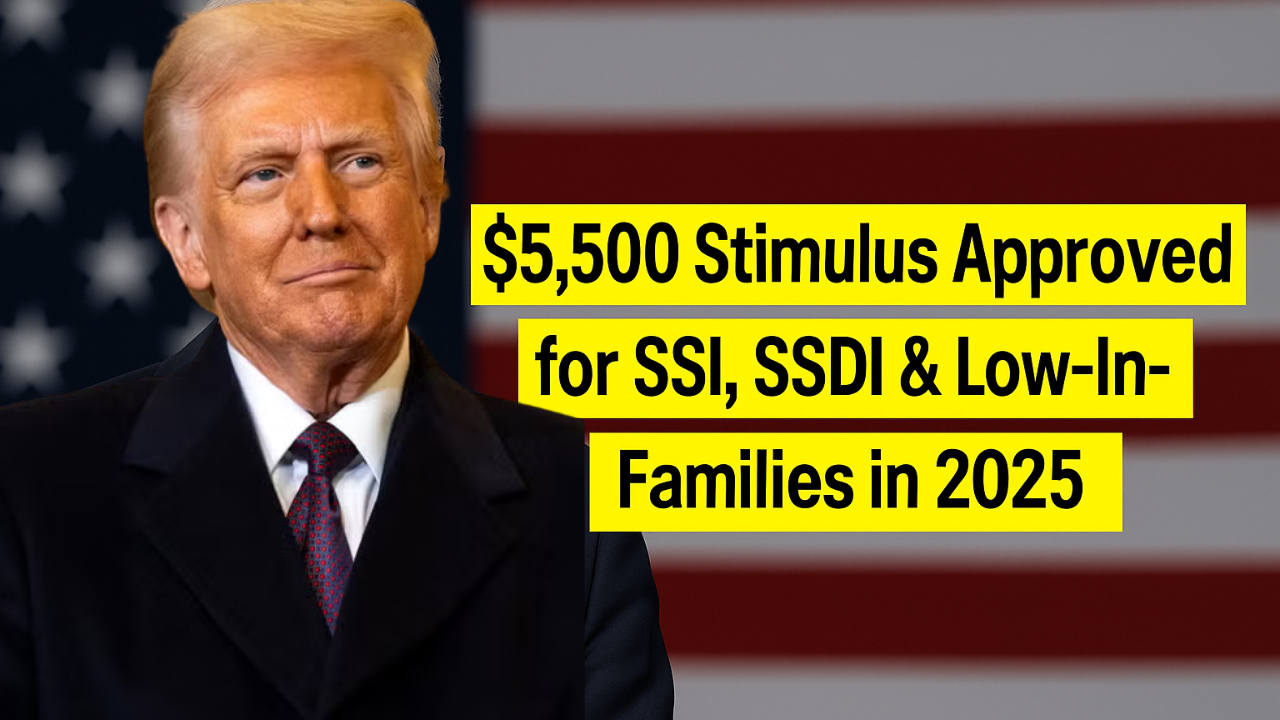Millions of Americans receiving Supplemental Security Income (SSI), Social Security Disability Insurance (SSDI), and other low-income assistance may be in line for a $5,500 stimulus boost, as part of a newly approved relief effort designed to combat inflation and support struggling households.
This direct aid package comes as families across the U.S. continue to face high costs of living, rising medical bills, and economic uncertainty. Here’s a breakdown of who qualifies, how the payment works, and what you need to do to claim it.
Overview of the $5,500 Stimulus Payment
| Key Detail | Information |
|---|---|
| 💰 Stimulus Amount | Up to $5,500 per eligible household |
| 🧾 Program Coverage | SSI, SSDI, low-income earners, veterans |
| 📅 Status | Approved – Payments starting soon |
| 🌐 Claim Method | Automatic for most federal beneficiaries |
| ✅ Eligibility Check | Income-based + benefit program status |
Who’s Eligible for the $5,500 Stimulus?
The new relief payment targets the most financially vulnerable Americans. You may be eligible if you fall under any of the following categories:
✅ 1. SSI Recipients
If you’re receiving Supplemental Security Income and have limited resources or income, you’re likely automatically eligible.
✅ 2. SSDI Beneficiaries
Those receiving Social Security Disability Insurance, regardless of age, can also qualify—especially if their monthly income falls below the federal threshold.
✅ 3. Low-Income Households
Families or individuals earning below $75,000 annually (single) or $150,000 (joint) may qualify. Those who receive SNAP, TANF, or other aid may also be included.
✅ 4. Veterans on Disability or Pension
Many disabled veterans or those on fixed military pensions are included, depending on income level.
How Will the $5,500 Payment Be Distributed?
The IRS and Social Security Administration (SSA) will handle most payments automatically, just like previous stimulus rounds. Here’s how it will work:
- Direct deposit to existing SSA or IRS-linked bank accounts
- Paper checks or EIP cards for those without direct deposit
- Payment tracking available through the IRS “Get My Payment” portal
If you’re enrolled in SSI, SSDI, or VA benefits, you won’t need to apply separately unless your banking info has changed or you missed prior stimulus checks.
What to Watch Out For
- Scams: Don’t respond to texts, calls, or emails asking for personal info to “verify” your eligibility. The government will never ask for banking details via phone.
- Eligibility updates: Some recipients may need to file a simple 2024 tax return to trigger payment, especially if they have non-taxable income.
How Is the $5,500 Amount Calculated?
The $5,500 figure can vary slightly based on household size, dependents, and income level. Here’s a general breakdown:
| Household Type | Estimated Stimulus |
|---|---|
| Single Adult (Low Income) | $1,400 – $2,500 |
| Couple (Both on SSDI/SSI) | $3,000 – $4,000 |
| Family of 4 (Low Income) | $5,500 (maximum) |
Each dependent may increase your total, making it possible to reach the $5,500 cap.
FAQs: Everything You Need to Know
Q: Do I need to apply to receive this $5,500 stimulus?
A: No application is needed if you already receive SSI, SSDI, or VA benefits. However, those with no recent tax filing may need to submit a return.
Q: Is this payment taxable?
A: No. The stimulus is considered federal aid and is not subject to income tax.
Q: Can I still get this if I missed previous stimulus checks?
A: Yes. You may still be eligible through a “Recovery Rebate Credit” on your next tax return.
Q: When will payments start?
A: The Treasury is expected to begin disbursing payments in late Q3 2025, depending on agency processing times.
Final Thoughts: A Lifeline for Those Who Need It Most
The $5,500 relief stimulus offers timely support to millions of Americans living on the edge. For SSI, SSDI, and other low-income recipients, it could mean food on the table, catching up on bills, or finally getting ahead on overdue expenses.
Keep your details updated with the Social Security Administration and IRS, and watch official government channels for payment updates

